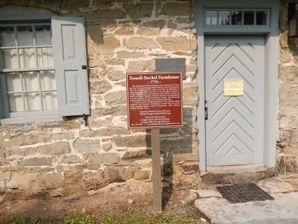Memorials

Located in the Trail of Tears historical park stands granite walls that have the names of Cherokees that were forcibly removed from their homes. Also lays next to it is a map that outlines the route of the Trail of Tears to show the path the Native Americans had to take.

The Trail of Tears Memorial was built by Larry Baggett to memorialize the plight of the Cherokee Nation’s forced march and relocation from the southeastern United States to Indian Territory in Oklahoma. Most of the concrete work is encrusted with local stone. Mr. Baggett studied Indian culture, astrology and numerology, and told visitors he created the monument to memorialize the plight of Native Americans, to whoms' ghosts he could speak with.

Smoky Hill Trail
The Smoky Hill Trail was the most direct route to Denver and the goldfields of the central Rockies. Immigrants heading west through central Kansas followed the Kansas River, then headed up its Smoky Hill River branch into the high plains of eastern Colorado. Here, the Smoky Hill River ended. Immigrants then turned northwest to Denver over the high, dry rolling prairie country. It was a tough stretch. A Denver newspaper called those who dared it "foolhardy and insane.... Read More

This memorial commemorates the Treaty of Greenville (1795) between the US and the indegenous peoples of Northwest territory (namely the Wyandot and Deleware peoples) which marked the end of a battle in Ohio during the 1930s between American army headed by Anthony Wade seized Native Americans led by the Blue Jacket of the Shawnee. The Native American signatories of this treaty agreed the cede their land south and east of the Cuyahoga River and the US would cede claims of land north and west of... Read More

[Panel 1:]
This German language monument, erected 1866, honors the memory of 68 men (mostly Germans) from this region who were loyal to the Union during the Civil War. Trying desperately to reach U.S. Federal troops by way of Mexico, about 40 of the men were killed by vengeful Confederates bent on annihilating them, in the Battle of the Nueces (on Aug. 10, 1862) and a later fight (Oct. 18). The bodies of the slain and those who drowned swimming the Rio Grande were left unburied. A group of... Read More

Organized for Ev. Lutheran beliefs - Sept. 9, 1853 by 75 Prussian immigrant families - Red brick church made of clay on site

“My memory does not begin with happy things.”
– Mathilda Gruen Wagner, daughter of German immigrants, 1860s
In 1845, hundreds of hopeful German immigrants came to the Texas Hill Country in search of land, political freedom and adventure. Johann “Casper” Danz, his wife Elisabeth and their baby boy Frederick were among them.
Tragedy struck the Danz family many times. Soon after they arrived in Fredericksburg, Elisabeth and her son died from an epidemic. Casper’s second bridge, Johannette... Read More

This Pennsylvania German farmhouse was constructed in 1756 by John Peter Troxell, an immigrant from Germany in search of a better life. When the structure was built, twenty years before the Declaration of Independence was signed, this farm sat on the edge of wilderness. George Washington was only twenty-four years old, and America was ruled by the King of England. At the time, the house was reported to be the largest residence on the Pennsylvania frontier. The fortress-like masonry walls of... Read More

Snaking its railroad down the western side of the Bitterroot Mountains, the Milwaukee Road burrowed 16 tunnels to maintain a uniform grade down to Avery.
These tunnels were dug largely by hand using sledgehammers and hand drills. In some cases steam-powered drills and steam donkey engines were hauled to the work site to speed the digging. It took three years, and the toil of hundreds of men before the massive job was completed and the St. Paul Pass Tunnel was opened in March of 1909.
(... Read More

